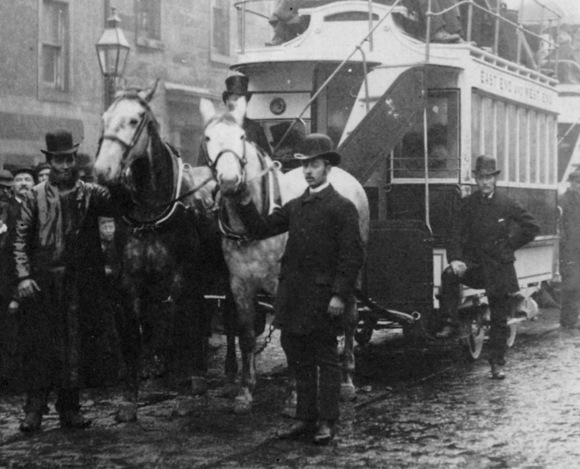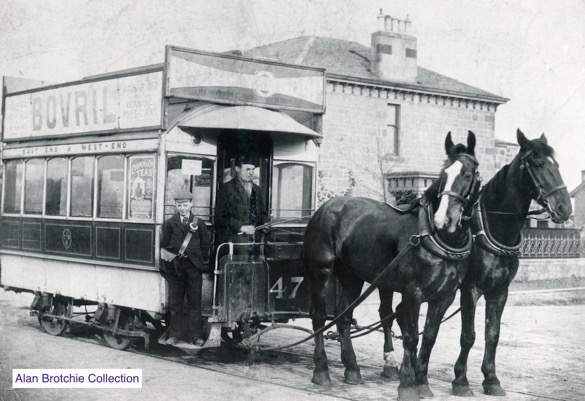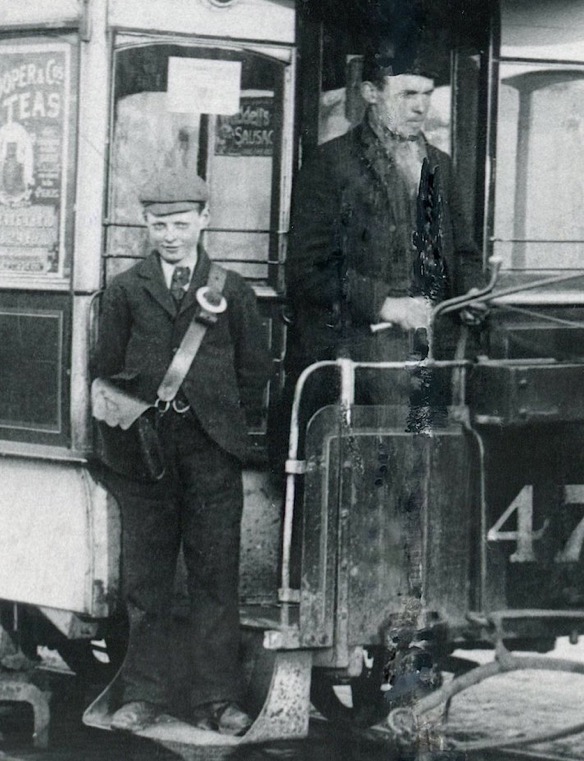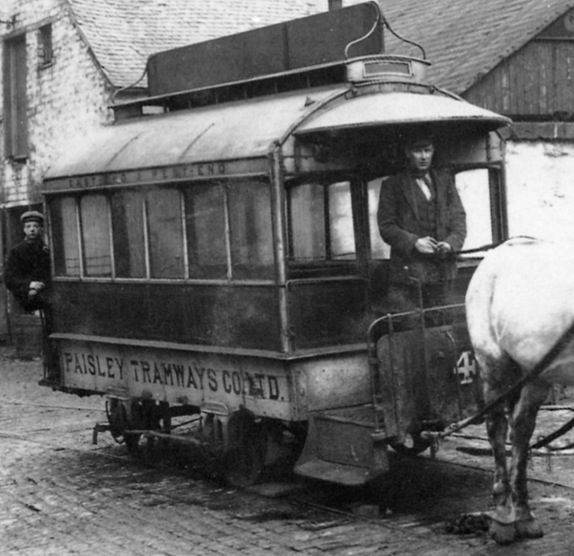Paisley Tramways Company
History
The Paisley Tramways Company was incorporated on the 24th December 1884 by several local luminaries, with the express purpose of promoting and building a tramway in the town. Powers to build a 2.5 mile, 4ft 7¾ins-gauge horse tramway were obtained under the Paisley Tramways Order, 1885, which was confirmed by parliament on the 22nd July 1885 (under the umbrella of the Tramways Orders Confirmation [No.2] Act 1885).
Construction of a 1-mile length of the tramway commenced on the 18th December. It ran from Broomlands in the west, through Paisley Cross to Garthfield Place in the east, and was opened just two weeks later on the 30th December 1885. The following year, the tramway was extended by circa half a mile, westwards to Thomas Street and eastwards to Greenlaw Road, the new stretches opening on the 20th April 1886.
Although a 5% dividend was declared in July 1886, the operating costs were high, not least because the heavy horsecars required two horses, a situation that was partially rectified in March 1887 by the purchase of two lightweight vehicles, requiring only one horse each.
Construction of the final extension, eastwards to Hawkhead Road, commenced on the 17th October 1888, the new section opening on the 29th November 1888. This took the tramway to its final size of 2.44 miles. From Thomas Street in the west, the line ran along Broomlands Street, Wellmeadow Street and High Street to Paisley Cross, continuing along Gauze Street, Garthland Street and Williamsburgh to the latter's junction with Hawkhead Road, the eastern terminus.
The tramway was never a money spinner, though it did manage to pay dividends until 1891, despite not having paid off circa £10,000 of the construction costs loaned by its chief promoter. The losses unfortunately continued, and despite threats by the chairman and directors — in both 1893 and 1895 — to close the tramway unless patronage increased, the tramway struggled on. Unsurprisingly, the company was keen to offload it, offering it unsuccessfully to Paisley Town Council in 1895.
Although a change in management and an improvement in local trade enabled the company to pay a dividend once again in 1897, this was eclipsed by other developments. An Extraordinary General Meeting was called on the 15th February 1897, at which it was announced that the directors had negotiated an agreement for the British Electric Traction Company to take over the tramway and convert it to electric traction, and also, to pay off the outstanding debt. The shareholders seemed unlikely to get a better offer for their small tramway, so readily agreed to the new deal, the BETCo effecting a conditional takeover from the 1st January 1898. The BETCo was a major player in the expanding electric tramway world, and was at the time aggressively purchasing horse and steam-operated tramways across the British Isles with the intention of converting them to electric traction, as well as promoting schemes for completely new electric tramways. At its zenith, it would either own, part-own or lease around fifty tramway concerns across the country.
The BETCo's plans were, however, opposed by Glasgow Corporation, which was determined to extend its own system from the city boundary into central Paisley, and had the support of Renfrew County Council. As for Paisley Town Council, everything seemed to be happening too quickly for its liking, and though the councillors were disinclined to have Glasgow Corporation tramcars in the burgh, they weren't ready to fully support the BETCo, as a result of which, the latter's application for a Light Railway Order (in 1898) failed. This was much to the consternation of the burghs to the west of Paisley, which the proposed BETCo tramway system would have served. Despite this, the BETCo persevered, bringing revised plans before the council in 1899, only for the council to then start a dalliance with another promoter, William Martin Murphy, who had close connections to the British Thomson-Houston Company. The council could not seem to make up its mind for more than a week at a time, first opposing Murphy's scheme, before briefly supporting it, only to then oppose it once again, before eventually supporting it again, though only in principle, all these machinations taking place in a matter of weeks in January and February 1900. The BETCo had clearly had enough of the council, which couldn't be trusted to maintain an opinion from one week to the next, so it formally withdrew its proposals in March 1900, leaving the PTCo without a buyer, the sale almost certainly having been conditional on a successful outcome for the electrification scheme.
The PTCo soldiered on, its vehicles in ever more decrepit condition, presumably hoping that either Murphy or the council would eventually buy them out. However, the latter's vacillations continued, with Murphy applying for powers to construct an electric tramway system despite its opposition. A sense of how weary officialdom had become with the council's shenanigans, can be gleaned from the fact that parliament voted to approve Murphy's bill, which was passed into law on the 17th August 1901, under the Paisley District Tramways Order Confirmation Act, 1901. It was purportedly the first tramway bill in the British Isles to be approved in the face of municipal opposition.
The act also incorporated a company — the Paisley District Tramways Company — to build and operate the electric tramway. The new company was also empowered to purchase the horse tramway, agreement being reached with the latter in early 1902, the PDTCo paying a fixed price as of the 17th February 1902, with interest paid until it formally took possession, which was to be 19 months later on the 17th September 1903.
The last horse tram service over the tramway — operated by the PDTCo — ran on the 21st November 1903.
Uniforms
A photograph taken on the opening day of the tramway clearly shows tramcar staff wearing smart but informal attire, comprising: heavy-duty jackets and trousers, shirts and ties, as well as long oilskin coats (the drivers at least), and the bowler hats of the period (tall with upturned brims). This attire was worn throughout the first decade of operation, but, from the mid 1890s, the company seems to have taken a more relaxed attitude to staff attire, resulting in a much more workman-like appearance. Staff at this time invariably wore a neck scarf rather than a tie, with flat caps preferred to bowler hats. Towards the end of the tramway's life, standards appear to have slipped even further, with tramcars looking extremely dilapidated, and staff almost shabby in appearance in comparison to the early years.
No insignia of any kind was carried, including municipal licence badges.
Photographs of inspectors are unknown, and it is entirely possible that the PTCo did not make use of them.
Further reading
For a history of the Paisley Tramways Company, see: 'Paisley's Trams and Buses' by A W Brotchie and R L Grieves; N B Traction Group (1986).
Images
Horse tram drivers and conductors
A Paisley Tramways Company horsecar outside the company depot on the opening day, 30th December 1885. All the tramway staff are smartly turned out in heavy-duty coats (and waterproofs), shirts and ties, along with the tall bowler hats of the period. Photo courtesy of the Tramways and Light Railway Society, with thanks to David Voice.
A very youthful conductor and his driver pose with Horsecar No 47 at the East End Terminus — photo undated, but probably taken in the mid 1890s. The high number of the vehicle is a municipal licence number rather than a fleet number.
An enlargement of the above photograph showing the crew in more detail, both of whom are wearing informal attire, devoid of any insignia.
A driver and another very youthful conductor pose with Horsecar No 43 at Incle Street Depot in 1903, shortly before the takeover by the Paisley District Tramways Company. By this time, standards of car maintenance and staff attire had evidently slipped considerably. Photo courtesy of the Tramways and Light Railway Society, with thanks to David Voice.